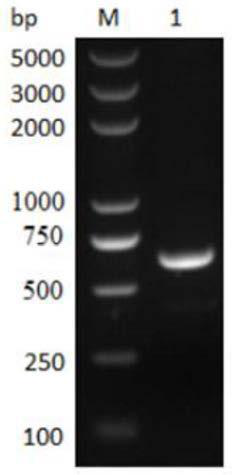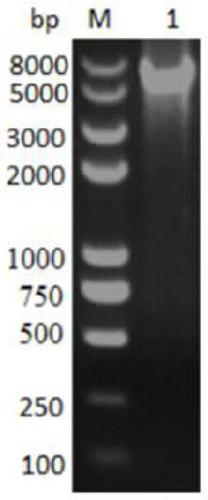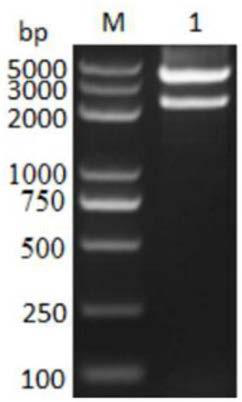Enzyme-linked immunoassay method for detecting sheep toxoplasma gondii igg antibody
An enzyme-linked immunosorbent assay, Toxoplasma gondii technology, applied in immunoassays, chemical instruments and methods, botanical equipment and methods, etc., can solve the problems of inappropriate large-scale inspection, low detection rate, time-consuming and laborious, etc., and achieve high sensitivity. , the effect of good specificity and easy automation
- Summary
- Abstract
- Description
- Claims
- Application Information
AI Technical Summary
Problems solved by technology
Method used
Image
Examples
Embodiment 1
[0028] Example 1: Preparation of dense granule protein GRA1
[0029] After extracting the RNA of Toxoplasma gondii, use the Takara reverse transcription kit to obtain cDNA, use the clonmanager molecular cloning software to design relevant primers according to the required target fragment, and amplify the target fragment by PCR method, and use the method of homologous recombination to synthesize GRA1-CDs The fragment was ligated into the pE-SUMO vector, and after being verified by enzyme digestion and sequencing, the constructed pE-SUMO-GRA1 plasmid was transferred to Escherichia coli BL21(DE3) for expression.
[0030] 1. Obtaining the target fragment of GRA1
[0031] (1) Extraction of Toxoplasma gondii RNA
[0032] Centrifuge the collected parasites, discard the supernatant, add 1ml Trizol to resuspend the pellet, and repeatedly blow and mix, then transfer the sample to a 1.5ml RNase-free centrifuge tube, shake and vortex vigorously for 3 minutes to fully lyse the parasites, ...
Embodiment 2
[0064] Embodiment 2: establish fast and accurate sheep toxoplasmosis on-the-spot diagnosis method (GRA1-iELISA)
[0065] 1. (1) Determination of antigen coating concentration and serum dilution multiple: Dilute GRA1 protein in gradients of 5 μg / mL, 2.5 μg / mL, 1.25 μg / mL, 0.625 μg / mL, and 0.3125 μg / mL, respectively, and coat ELISA plate, each concentration is coated with a column of 5 wells. Dilute negative and positive control sera with warming solution at 1:25, 1:50, 1:100, 1:200, and 1:400, respectively, and add each dilution to 5 wells in a row. Operate according to the routine steps of ELISA, and measure OD with a microplate reader 630 value, compare the size of the P / N value corresponding to each antigen, and select the antigen coating concentration and serum dilution factor corresponding to the maximum P / N value of the optimal antigen as the optimal condition.
[0066] (2) Optimization of the optimal blocking concentration and optimal blocking time: optimize the blocki...
Embodiment 3
[0088] Embodiment 3: Sensitivity test and specificity test of sheep Toxoplasma gondii indirect ELISA detection method
[0089] According to the method of Example 2, 1:25, 1:50, 1:100, 1:200, 1:400, 1:800, 1:1600 dilutions were respectively performed on 5 parts of positive sera for detection, and set positive, negative, Blank control. The results are shown in Table 2. The results show that the sensitivity of the GRA1-iELISA diagnostic method established in the present invention is greater than 1:100. The established method was used to detect the positive sera of goat aplasma, goat Babesia mosoni, goat Theileria reuteri and goat positive sera of Haemonchus contortus. The results are shown in Table 3. The results showed that the specificity of this method was good, and there was no cross-reaction with Babesia mosoni, Theileria reuvei and Haemophilus contortus.
[0090] Table 2 Sensitivity test results
[0091] Dilution factor
1:25
1:50
1:100
1:200
1:40...
PUM
 Login to View More
Login to View More Abstract
Description
Claims
Application Information
 Login to View More
Login to View More - R&D
- Intellectual Property
- Life Sciences
- Materials
- Tech Scout
- Unparalleled Data Quality
- Higher Quality Content
- 60% Fewer Hallucinations
Browse by: Latest US Patents, China's latest patents, Technical Efficacy Thesaurus, Application Domain, Technology Topic, Popular Technical Reports.
© 2025 PatSnap. All rights reserved.Legal|Privacy policy|Modern Slavery Act Transparency Statement|Sitemap|About US| Contact US: help@patsnap.com



